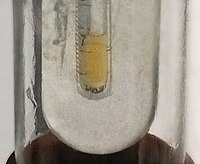
Photo from wikipedia
In the present work, vortex-assisted liquid-phase microextraction (VA-LPME) and ultrasound-assisted liquid-phase microextraction (UA-LPME) techniques were used for the speciation of chromium (Cr 3+ /Cr 6+ ) followed by their determination… Click to show full abstract
In the present work, vortex-assisted liquid-phase microextraction (VA-LPME) and ultrasound-assisted liquid-phase microextraction (UA-LPME) techniques were used for the speciation of chromium (Cr 3+ /Cr 6+ ) followed by their determination using flame atomic absorption spectrometry. 1-(2-Pyridylazo)-2-naphthol (PAN) was used as a chelating agent to form a hydrophobic complex with Cr 3+ ; then, it was extracted by choline chloride–phenol mixture, as an extraction solvent. A solution of 1.0 mol L −1 ascorbic acid was used as a reducing agent to convert Cr 6+ to Cr 3+ (total chromium), and the concentration of Cr 6+ was determined from the subtraction of Cr 3+ form total chromium. The efficiency of two microextraction techniques was compared in terms of type and amount of extraction solvent, type and volume of extraction solvent, pH of solution, volume of tetrahydrofuran (THF), and extraction time. Based on the obtained results, the extraction recoveries of VA-LPME and UA-LPME techniques are 52% and 60%, respectively. Therefore, UA-LPME is superior technique than VA-LPME. By optimizing different parameters affecting the recovery percentage (RP) of Cr 3+ , the calibration curve was depicted in the concentration range of 1.5–375.0 ng mL −1 Cr 3+ with a correlation coefficient of 0.9937. The limit of detection was 0.4 ng mL −1 , and the relative standard deviation (RSD%) for seven replicate analyses of 50.0 µg L −1 of Cr 3+ was 3.6%. Finally, the UA-LPME method was successfully applied for the determination of Cr species in different food and water samples.
Journal Title: Journal of the Iranian Chemical Society
Year Published: 2020
Link to full text (if available)
Share on Social Media: Sign Up to like & get
recommendations!